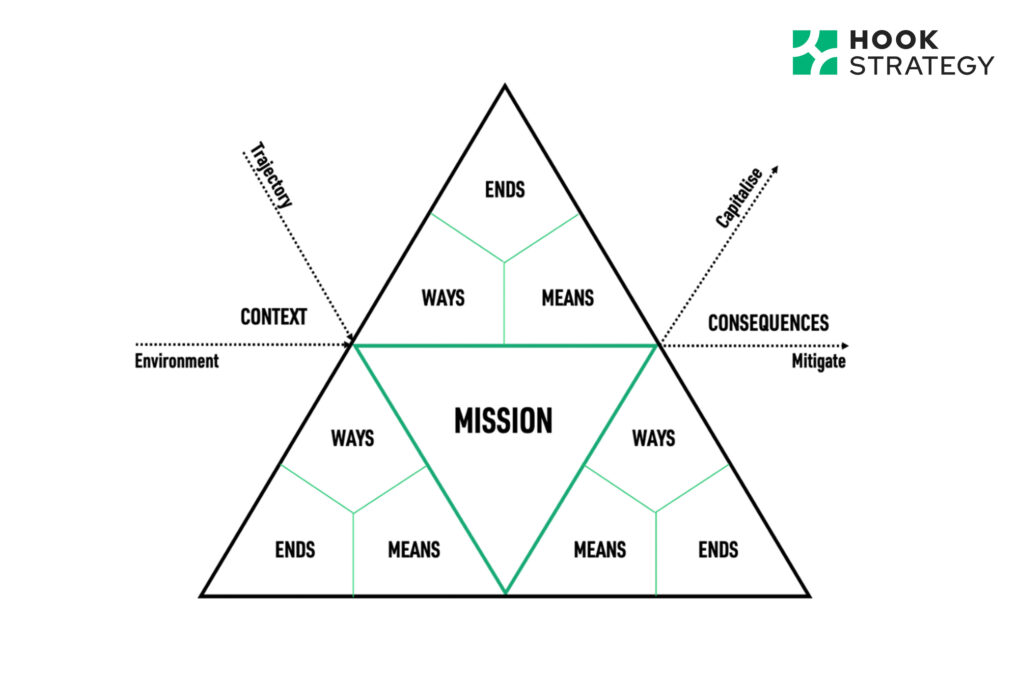Clear strategic development is essential for any business, brand or team. It should be a truly democratised discipline, that can be practically integrated into the dynamic pace of daily life, developed periodically, and revisited regularly.
But it tends to be the most over-complicated and mythologised disciplines out there, which is a shame, because it should be fundamental, and frankly enjoyable.
The confusion around the discipline can lead to it being debated and developed in a silo, various crucial voices either excluded, or self-excluding on the basis that they are ‘not strategic’. Firstly of course, there is no such thing as a non-strategic person; secondly strategic development that ignores the financial, operational or human understanding held by those excluded individuals is likely to be straightforwardly worse and less effective.
Even worse, there are many business, teams and brands out there that frankly don’t have a strategy at all. This tends to be particularly true in the situations of the greatest pressure, confusion or anxiety, which is a bit like leaving the lifejacket behind because the waters are too choppy.
The Clarity Framework
There are many great guides and frameworks out there, with a variety of different lenses from the highly creative to the extremely operational. What I find most users need is an approach that is holistic, simple, and built for real life.
With this in mind, I have started capturing and formalising my underlying process for strategic development.

Obviously, I believe in the value of an expert practitioner and facilitator to support this process, but if anyone would like to use this to support their thinking, I’d be delighted.
Each of the elements in this model will be unpacked in more detail over time, but firstly a brief introduction to the fundamental elements.
1. CONTEXT: Trajectory & Environment
Your strategy doesn’t exist in a vacuum – it is operating in a dynamic context of shifting human behaviours and economic and social change. It’s difficult in the Age of Information not to be hyper-alert to change, which can present its own issues. But you will be surrounded by implacable certainties and a strategy that adapts to and moves with those dynamics is much more likely to succeed.
It’s obviously essential to understand the context against which the next 2-3 years will unfold. But also, to remember that you yourselves are a unique player against this backdrop. Your future is not a blank page, but will be shaped by your historical successes, failures, quirks and capabilities. In fact, this is where I would start: with you.
Whether looking inside or outside, it’s incredibly easy to get drawn deep into the rocks of fear, unnecessary detail, or future-gazing. Context mapping needs to be realistic, focused, and relevant.
2. BUILDING BLOCKS: Ends, Ways and Means
Ends, Ways and Means are the fundamental elements of any strategy.
Ends are your objectives – and they should always be quantifiable, stretching but achievable, and compatible with each other.
Ways are your key routes to get there – the prioritised methodologies and practices that maximise the probability of delivering those Ends.
And your Means are everything you require to get there – people, time, money, materials, partnerships and skills.
It’s fairly common for people to think about Strategy as a discipline of Ends and Ways, and to fail to think about what needs to be true or needs to be present for this to be possible. Strategy that fails to deal with the challenges of its materials is unlikely to succeed. And it is only once you have thoroughly explored the Ends, Ways and Means together that you can explore the actions required to deliver success.
The key discipline here in creating these building blocks is focus. My model is built on the premise that there are 3 End around which the strategy is built. This is of course arbitrary, and you should have as many key objectives as you need to have. BUT without focus, people will not understand them, and you will not be able to prioritise.
It often turns out that three is the magic number. But the way to find the right balance is to thoroughly explore your objectives, and how they inter-relate, and how they ladder. Of which one key element if finding the single, over-arching goal that links everything together. Which is where we come to the Mission.
3. MISSION: The ‘one thing’
As you’d expect, the most difficult part of any complex problem is trying to find the single thread from which all elements of the strategy should flow.
There are a variety of schools of thought on what has primacy here – eg the brand purpose vs the business outcome – and people’s opinions on this can be quite doctrinaire. I think it’s very healthy to be open-minded about what kind of mission you have for your team or your project, but it has to fully represent the change process that you are looking to take people through. If it fails to represent either the commercial reality in which you operate, or the emotional root that is going to unify and motivate people, then it will fail in its task.
The Mission therefore needs to be universally relevant to everyone who is going to deliver it; stretching but not incredible; quantifiable but not simply ‘the budget’; and it has to be well crafted and easy to communicate.
This then leads to thoughts about when in the process it needs to be done. Apart from an overarching principle that strategy is not linear and that all parts of it should be revisited at all stages, it is particularly imperative that the Mission is reviewed at the beginning, the middle and the end of the process to ensure it is expressed as perfectly as possible.
4. CONSEQUENCES: Capitalise & mitigate
Any human being who has just worked with their team to define their context, their mission and the key building blocks of their strategy will be desperate either to crunching into a list of actions, or getting back to the day job. But the job is not yet done.
One of the things that people most often miss about even the greatest strategy, or for that matter execution, is that it is a game of probabilities. Everything we have done thus far has been laying a series of bets that if properly executed maximise the chances of a good result.
From the moment everyone walks away from the table, the chances of the scenario being correct begin to decline. From the moment everyone first takes significant action around the strategy, the future scenario has been disrupted and the feedback waves of unintended consequences will begin.
This is why preparing for the most likely consequences, good and bad, is fundamental. This isn’t about preparing for every scenario – that’s a function of resilience, improvisation and collective wisdom. But it is, or should be, about preparing for the 2 or 3 most likely positive or negative scenarios.
There are lots of good ways of doing this – some of them analytical, some of them much more playful. Certainly, one of the most enjoyable is to imagine finding yourself significantly ahead of one or two of your key metrics of success…what would you do with the unexpected resources and reputation that you now find yourself with? Perhaps more crucially, this may be a good time to engage with your greatest cynic and to look at what happens to the strategy if one fundamental engine fails to fire?
Conclusion
Some things to remember:
- Understand your context, and be clinical about what’s relevant and real
- Remember that your own trajectory is a part of your context
- Prioritise your Ends, and how they inter-relate
- When thinking about the Ways, don’t forget about the Means
- Create a Mission that you can (just about) achieve
- Prepare for unintended consequences
- If your strategy is unclear, take the time and get the help to clarify it
Hook Strategy helps organisations to move forwards with shared strategic clarity. If you are an organisation seeking unified thinking, get in touch at contact@hookstrategy.com or by calling +44 (0)7780 481717.

